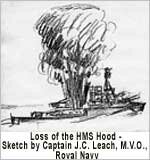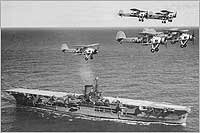August 5, 2011 — Photo of the Day
Mulberry Artificial Harbors - Normandy

Completed Mulberry harbor - WWII Normandy. September 1944.
A - breakwater composed of concrete Phoenixes and blockship Gooseberry. B - Spud pier for unloading. C - floating whale roadways. British government photo.
By June of 1943, nearly a year after the disastrous raid on Dieppe by the British, Europe was still firmly in German hands along with all its ports. Although the failure at Dieppe showed that a port could not be easily captured, a deep port was essential if the Allies were to begin their assault on the French coast.
The calm waters of a harbor were necessary to allow a continuous supply of troops and equipment to a newly opened front which was being planned as Operation Overlord.
Difficulties of a Captured Harbor
The choices available to the Allies for obtaining a harbor included an attempt to capture a port or build their own. The ports at Cherbourg and Le Havre were closest to England but also the most heavily defended. It was realized that not only heavy losses could be expected, but if the port could be taken, it would not be particularly operational for some time due to damage incurred during the battle. Sunken ships would need to be cleared out and harbor repairs, or new construction carried out. It was felt that this could take many weeks to accomplish, all while trying to hold the port without a ready means to receive troops and supplies.
Artificial Harbors: Mulberry A and B
Code named Mulberry, a daring plan was put into action. It included two prefabricated harbors, each containing breakwater, piers and roadways all of which would be built in England. These components would then be towed across the English Channel and set up at two locations, following the initial attack on the Germans at Normandy. The American Mulberry A harbor would be constructed on Omaha Beach, and the British Mulberry B on Gold Beach. Plans and construction prior to D-Day, would be kept in utmost secrecy in order to gain the element of surprise. It was initially estimated that an artificial harbor could support 12,000 tons of supplies and 2,500 vehicles per day once it was in operation.1
Notes
1John P. Taylor, The Prefabricated Port of Arromanches — Mulberry B. London: Shipbuilding and Shipping Record, 1945. p.5.
Jon’s WWII Blog
Latest Posts
April 10, 2011 — Reworking the Normandy section, focusing on specialized vehicles with updates every few days.
February 14, 2011 — Naval Aviation Centennial at San Diego: photos and video of the Parade of Flight to be uploaded soon.
October 17, 2010 — New content being added regularly, including updated articles and new pages.
Comparison of American and German Tanks & Tank Destroyer Philosophies
American Tanks
A tank is a tracked vehicle with armor and at least some of the weapons located in a rotating turret. American tanks were intended to exploit breakthroughs by infantry, moving rapidly to strike deep into enemy lines and disrupt command, supply, and reserve units.
American Tank Destroyers
Designed to counter enemy tanks, American tank destroyers had large engines, powerful guns, and very thin armor—favoring speed and mobility. They typically lacked enclosed turrets, making them vulnerable to infantry and artillery.
German Tanks
Early German doctrine called for infantry-support tanks and battle tanks. Both types were fast and formed into armored divisions. Over time, tank designs evolved to counter new threats and keep pace with enemy advancements.
German Tank Destroyers
Prompted by encounters with Soviet T-34s and KV-1s, the Germans began converting tanks into dedicated tank destroyers with stronger guns, heavier armor, and lower silhouettes. These vehicles were intended to engage and defeat enemy tanks directly.
P-51 Mustang

P-51 Mustang
The P-51 Mustang was built at the request of the British, who needed more fighters than they could obtain from Curtiss. North American Aviation proposed a new design, resulting in the P-51 Mustang. Initially a great low- and mid-altitude fighter, it was vastly improved when fitted with the British Rolls Royce Merlin engine, becoming a top high-altitude escort fighter for Allied bombers.
Scale Model Teaching Collection
A growing collection of 1/32 scale WWII models, focused on tanks and aircraft from all major nations. Each model tells a unique story, often with variants reflecting different uses or service in various countries.
More Thoughts on the Swordfish Torpedo Plane

Loss of the HMS Hood
The Swordfish played a key role in disabling the Bismarck's rudder, leading to its destruction. Famous for daring torpedo attacks in poor weather and at low altitude, the Swordfish exemplified the adaptability and bravery of WWII aviators.

Swordfish leaving Ark Royal
The Swordfish also attacked the Italian fleet at Taranto, inflicting heavy losses and shifting the balance in the Mediterranean. Later, it was used for anti-submarine duties.
New Articles & Photos
New Articles & Photos |
|
|---|---|
Normandy
|
|
|
|
Weapons
|
|






